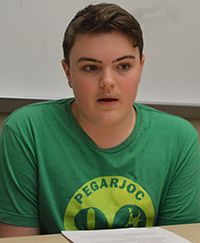A room full of authors gathered at Cedar Springs Middle School. One was a guest speaker, author David Stricklen, and the rest were seventh-graders.
Students in Amy Blauw’s class have spent the past several months crafting their own page-turners through collaboration, analysis of a novel and sharing their work in the author’s chair.
Stricklen, visiting earlier this month, talked about his career as the author of the Blackwater Pond series, and enlisted students to help him make up stories on the fly. The Grand Rapids area author is former chief of police at Gerald R. Ford International Airport and often gives presentations at schools.
“The biggest thing from him is you can turnanything into a story,” seventh-grader Eli Oser said. Eli’s own fictional story chronicles a cast of characters with special abilities who go to battle over territory. The idea was inspired by a classmate whose story also focuses on a battle, Eli said.
Classmate Emma Cassidy said her story came in part from a friend in class, but also by turning an ordinary event into something extraordinary. Her story tells of a sleepover gone horribly wrong, resulting in kidnapping and the teamwork of good friends to escape.
Stricklen called on students to add pieces to a story based on a series of unrelated images on a projector screen. He encouraged students to imagine how these things — a scuba diver, a muddy boot and the surface of Mars — could possibly fit together.

Stricklen left students with a lesson on word choice.
“‘Look’ is a real common one,” he said. “There’s probably a better one you can use. A little bell should go off in your head.”
“Peered” and “peeked,” students suggested. In Eli’s story, he used “catapulted” in lieu of “jumped.”
“One of the essential questions that we have the kids ponder is, ‘What are some writing skills you’ve learned from David Stricklen?'” Blauw said. “How can you apply those to your own writing?'”
The author’s chair
In the author’s chair, students read their creations aloud to the class, who then respond with questions and encouragement.
In a recent session, Emily Sprague read her story “Hidden Sorrow” about a girl obsessed with becoming prom queen, whose prom night ends with her tied to a tree at gunpoint. One student said she liked Emily’s use of foreshadowing, while Blauw said she loved the buildup of suspense.
Once the students have completed multiple drafts of the stories and received feedback from their classmates, they can choose a piece of writing from any time during the school year to be included in a bound anthology. This will be added to anthologies from previous years’ classes for future students to read.

The hard part
For Eli and Emma, beginnings and endings are the most difficult part of crafting their stories.
“The hardest part is probably coming up with the story,” Emma said. “I can’t figure out how to end them or how to start them.”
“What usually gets me stuck when I’m writing is when it’s a tough spot at the end of a scene, and I have to figure out what I want to do next,” Eli added. “A lot of times if I’m doing a ton of characters, it’s hard to think of a ton of names.”
To get students in the groove, Blauw provides examples from all kinds of sources. They include reading “The Gardener,” a dystopian novel, David Stricklen’s advice and Blauw’s own writing.
“We chunk it out and we write one section at a time,” Blauw said. For students with writer’s block, she added, “We always start with a graphic organizer where they can list story elements they’re thinking of, and events from their life.”
“The Gardener” has been a mentor text for several years. To replace worn-out copies, media specialist Shari Anderson applied for a grant for a school set so future students can each have their own copy.

Reaping rewards
Through a regimen of reading, writing and sharing, Blauw said students have demonstrated their ability to pick out themes, imagery and other story elements from their reading and connect them to their own work.
For Eli, writing is part of his life. In addition to playing the guitar and piano, he likes to write songs. He finds music and writing the best ways of expressing himself.
“I like being able to write,” Eli said. “It’s the same thing when I write my songs. I can write stories that pop in my head. It’s a different kind of way to show what’s going on in your mind.”
CONNECT









